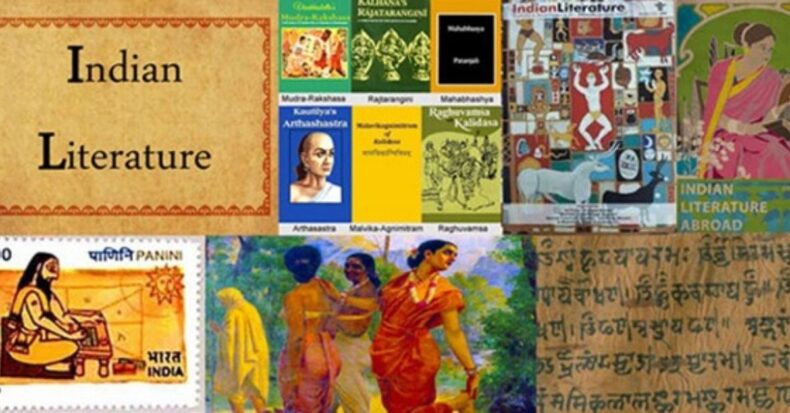Indian Literature undeniably is one of the oldest traditions globally, which embraces more than 22 officially acknowledged tribal and foreign languages, including Persian, Portuguese, French, and English.
Introduction to the history of Indian Literature
The work of Literature fabricated in the Indian subcontinent is referred to as Indian Literature. Albeit it is commendable that a remarkable amount of Indian Literature is in the written form, a plethora of it is communicated verbally in regional languages.
Indian Literature is a specific group of texts produced over a set geographical area and within a particular period. Indian Literature, in this sense, or rather ancient Indian Literature, consists of two primary forms: classical Sanskrit texts and works in the various vernacular languages of India.
Sanskrit literature has the most significant role in the Indian literary tradition. The holy Vedas, Puranas, Upanishads, and dharmashastras are all written originally in Sanskrit. The Vedas are the books of knowledge that preach Shiksha (education), vyakarana (grammar), Kalpa (ritual), nirukta (etymology), chhanda (metrics), and jyotisha (astronomy).
Works written in the various vernacular languages of India, on the other hand, can be broadly grouped into two categories: prose texts and epics. The former includes works such as the Mahabharata and Ramayana, while the latter group includes such works as Gitagovinda (around 400 BC) and the Mahabharata (approximately 400-500 AD). Both types include many anthologies.
The period of Indian Literature extends from about 1500 BC to AD 1200. This period is traditionally known as the Vedic age, and it is also called the classical age or (more informally) the golden age of Sanskrit literature.
It can be inferred that the first ancient Indian Literature was Sanskrit literature encompassing Vedas, epics, and Upanishads followed by Urdu, Marathi, Bengali, Hindi, and more into the modern times.
Indian Literature in Indian languages
In the medieval period, Indian Literature extended its wings into new dimensions embracing various other Indian languages such as Assamese, Bengali, Gujrati, Kannada, Konkani, Malayali, Marathi, Manipuri, Mizo, Oriya, Punjabi, Rajasthani, Telegu, Tamil, and Urdu.
Assamese Literature:
Though the emergence of Assamese is tracked down in the 7th century, its literary culture came into eminence in the 13th century with the arrival of the Vaishnava founder, Shankar Dev, who created creative drama, epic, and songs in Assam. The custom of fiction novel writing commenced in the 19th century by Padnath Gohai Barua and Rajnikant Bardolai.
Bengali Literature
In the interim of its evolution, Bengali literature confined its realm within the Nath School of thought and romanticism of Radha Krishna. The tradition of contemporaneity in Indian languages came into exposure first in Bengali literature, and the British colonists imparted English thoughts into the Bengali writings.
Hindi Literature
The tradition of contemporary Literature came into existence during the 19th century. The entire history of Hindi literature can be contemplated by segregating it into three significant phases. The first phase is named the Aadikal (1050-1375), when court poems were in demand. The second phase is called the Bhakti Kal (1375-1700), during which devotional, literary works became popular. The third phase is the Ritikal (1700-1900); hitherto, the Hindi literature had evolved well.
English Literature
Rabindranath Tagore became the first Indian writer to win the Nobel prize for his work of Literature in 1913. Tagore represents a holistic mixture of the ancient Indian tradition and the new European consciousness.
Raja Rao’s ‘The serpent and the Rope’ is considered one of the essential English Novels to have appeared to date.
Vikram Seth, Salman Rushdie, Anita Desai, R K Narayan, Mulk Raj Anand brought some major turning points in the English Literature tradition in India.
The acknowledgement of foreign languages in India, especially the English Language, brought several revolutionary reforms. Indian Literature’s rise is credited to the association of social codes between the Indians and the British.
When the Indians embraced western education, it resulted in the growth and development of Indian Literature. The Indian writers started adopting the style of writing in line with the teaching of the west.












